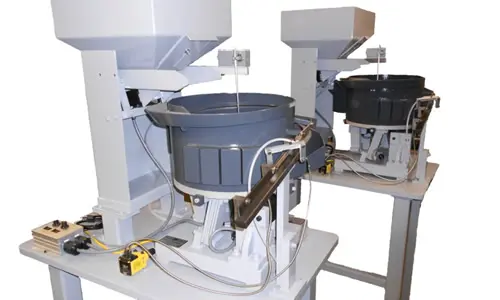Vibratory Feeder Bowls
Vibratory feeder bowls are devices used to sort bulk components and orient and discharge them into the production line. Centrifugal feeders use electromagnetic vibrations that convert into mechanical vibrations that gently shake the parts to separate them. As the bowl feeder vibrates, tooling components inside the bowl help orient the parts in a specific direction. Once the pieces are correctly aligned, they are fed down a track and into conveyor chute that leads to the production line.
Trusted Components for OEMs, Integrators, and Maintenance Teams
Browse our superior-quality components using the options below. All our components are tested for performance and ready to ship, providing reliable solutions for engineers, MRO teams, and system designers. Need help finding the right part? Request a quote or connect with our team today to get started. Universal Power Conversion is your one-stop source for pneumatic, hydraulic, electrical, and industrial automation components.
Vibratory Bowls Improve Assembly Line Efficiency
Feeder bowls are designed for high efficiency and commonly used for pick-and-place and automatic handling systems. Vibratory bowls are highly versatile and designed to handle multiple types and sizes of parts. They take up minimal space and are customizable based on your application needs.
Vibratory feeder bowls also provide cost savings by providing a faster and more efficient alternative to manual sorting. The safe and simple operation makes it easy to implement these high-efficiency systems throughout your assembly line.
Bowl feeder systems provide automated solutions for numerous industries and applications, including electronic, automotive, food production, consumable goods, packaging, cosmetic, pharmaceutical, recycling, construction, and many others.
How To Choose A Bowl Feeder System
Vibratory feeder bowls can have a simple or complex configuration, depending on what your application requires. A simple configuration, for example, can sort and feed screws in a horizontal position. A complex feeder bowl configuration will orient the screws so that each one dispenses on its head and in a vertical position. Part size and the rate at which the product is dispensed are also factors that determine system configuration.
It is important to consider all factors to ensure you choose a centrifugal feeder that provides the consistency and efficiency you need. The requirements for your vibratory feeder bowl depend on the configuration of your production line and other factors including:
- The rate, or parts per minute (PPM), at which parts need to be dispensed
- Size of the area where the machine will be installed to determine appropriate base and feeder bowl
- Desired orientation of the parts as they fall, which determines the type of guides required in the bowl feeder
- Size and quantity of parts being sorted, which determines your required bowl capacity and bowl diameter
- Type of controller required and appropriate voltage rate to ensure compatibility with the centrifugal feeder voltage rate
Vibratory Feeder Bowls for Production Line Automation
Universal Power Conversion, Inc. (UPC) is the Manufacturer Representative for Feeding Concepts in Minnesota, Wisconsin, North Dakota, South Dakota, Nebraska and Iowa. Feeding Concepts is an established leader in the parts feeder handling and vibratory feeder orienting industry. Their durable and reliable feeder bowls come in standard and custom configurations and are made to handle demanding applications.
We offer a range of complete vibratory feeding solutions including new and used vibratory feeders and automation components, as well as secondary services, including bowl feeder system refurbishing and retooling. Our bowl feeder bowl options include Polycast® vibratory feeders that provide the flexibility to adjust the feeder to accommodate different fastener types. We also offer QC® drive units, stainless steel vibratory feeders and total turnkey centrifugal feeder systems for your line tooling requirements.
Our diverse offering of vibratory feeder bowls and systems means you can find everything you need in one place, including multiple line tooling and adjustable tooling options for your production line.
Learn More About Our Bowl Feeder Systems and Components
Contact us to learn more about our vibratory feeder bowls and other automated sorting solutions to help increase production line productivity.
Some of the industries we have served:
| Ammunition | Electronic | Foundry |
| Automotive/Transportation | Food Processing | Steel |
| Medical | Fast Moving Consumable Goods (FMCG) |
Construction |
| Fasteners | Packaging | Recycling |
| Industrial | Metalworking | Pulp and paper |
| Pharmaceutical | Glass | Plastics |




